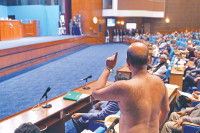Special Supplement
Why it’s difficult to call Prime Minister Oli’s foreign policy “balanced”
There is an unintended paradox in Nepal’s basic position of equidistant foreign policy.
Amish Mulmi
There is an unintended paradox in Nepal’s basic position of equidistant foreign policy. Whatever Kathmandu’s position on its relationships with our two neighbours, the interactions of those who live on our borders will remain constant. This is more pronounced for those who live near the Indian border: the flatlands and the 1950 treaty both allow for greater ease of movement; the cultures are similar; and trade across this border remained unimpeded for the most part even during the last blockade. On the northern border, as I have written previously, despite the high passes and remote terrain, locals have recently begun to profit from China’s economic push.
New era, new relationships?
Any annual review of a year-old government’s foreign policy must concede that it is too short a time frame for a clear definition to emerge. To Oli’s credit, there is a continuity in his government’s approach during his short-lived 2015-16 reign and after the elections. Despite the nationalistic bluster, ‘equidistance’ in Nepali foreign relations means a withdrawal from Indian influence and a bent towards China. Oli is not the first Nepali leader to try this; both King Birendra and Mahendra exercised this policy, only to their detriment when they found China was not willing to back it when Indian pressure increased. Call it good fortune, call it circumstances, China’s rise as a hegemon in South Asia has Delhi on the backfoot. But has Kathmandu profited from it?
After months of boastfulness, muted reactions now greet the proposed Kathmandu-Kerung railway. Progress on its development has slowed down; we are finally down to the most important question of costs (which should ideally have been the first), as fears of a Chinese debt trap loom. While some infrastructure projects have shown impressive results–the upcoming Pokhara airport, for one–others have languished–such as the Tatopani border, which was the primary road connection. Amid calls that China should fully finance the railway, there is a tentativeness to Nepal’s newfound bonhomie with China. It is almost as if the Oli government is wary of India’s reaction, despite his bombast against Delhi’s interference.
On the other hand, the Oli government’s dealings with its counterpart in India is visibly less than in previous governments. Perhaps that is a good thing: Oli is keen to maintain his show of defiance. But it has also been a worrying year of silence vis-a-vis Delhi. The Modi government is besieged by domestic issues leading up to next year’s election; even so, it found the time to declare its support for the new Maldives government and committed itself to a $1.4 billion financial assistance to the island-nation. Its silence on the Eminent Persons’ Group’s report speaks volumes subsequently. India is biding its time; with little clarity on how Nepal can delink its economy from India, Delhi can do so. At the same time, India is keenly aware of Chinese inroads into South Asia, and although it may be willing to cede certain elements of its influence, it will draw the line on security matters. If anything, one should expect a reorientation, if it is to come, in Delhi’s Nepal policy only after the 2019 general elections.
One must also understand the pragmatism that governs the Sino-Indian relationship at this moment despite their traditional acrimony. President Xi’s two-plus-one initiative could not be clearer: trade relations between the two are at an all-time high; China needs the goodwill of India in its ongoing trade war with the US; as the Chinese economy slows, India remains a major market for Chinese consumer goods; and although the border provides flashes of dispute, economic considerations will override them, as we’ve seen from the Wuhan declaration. To imagine ‘China replacing India’ in Nepal within this scenario is misguided.
With Nepal’s exports primarily being labour for the markets of West Asia and South-East Asia, the Oli government has reached out to them for better terms and security for Nepali workers. However, labour markets are primarily based on costs; it suits these countries to retain the Nepali working population as an unskilled pool of labour. If Oli is serious about a ‘new era’ for the country, he would do well to think about intervention in the form of transformative educational institutions–whether with the help of China or India or a third country, or by itself.
On the final front, with respect to western governments, Oli has been clear about their reduced mandate in Nepal. Despite the US’s assurances that Nepal has a ‘central role’ to play in its Indo-Pacific engagement, it is now clear that the West, which pushed for a more open world through globalisation, is now turning inwards. The US is withdrawing from its international commitments. The attitude of Western governments towards immigration is plainly clear. In such a scenario, it is more pragmatic for a sandwiched nation like Nepal to reorient itself towards its neighbours, which will become the world’s two largest economies by 2050.
Not so balanced
By all measures, it would be difficult to call Oli’s foreign policy ‘balanced’; it is clear he prefers China to India, which coincides with the populist view. But it is also clear the reasons are more political than pragmatic. Oli has never been a favourite of South Block, and he will milk the 2015 blockade as much as he can. Whether that can transform into a commitment on China’s part is something he has little control over.
Despite the increased engagements between Beijing and Kathmandu, there are far too many whispers to ignore: Nepal is woefully underprepared in its dealings with Beijing; the Chinese are perplexed by the ease with which contracts are cancelled and redrawn in Nepal; and Nepali officials make far too many trips to China without results. One simple example of the latter should suffice: in late August, two high-ranking Humla district officials visited China purportedly for a security meeting. The officials, along with their wives, travelled to Kailash-Mansarovar for a quick pilgrimage (I couldn’t confirm whether any meeting actually took place; if local news reports are to go by, it didn’t). On their return, locals at Hilsa informed them about the various cross-border issues they were facing. One of the officials asked them to come to Simikot to register an official complaint. Enraged, the locals gheraoed them, and the two officials escaped to Muchu, leaving their wives behind in Hilsa.
On the other hand, the Oli government’s dealings with India leave little to be satisfied about. The ambassador’s position had been vacant until recently; the embassy in Delhi has little knowledge about inter-country visits by eminent persons; and there is little trust between the two countries’ officials. If Delhi is to be held responsible for the lack of trust (because of the blockade), Kathmandu must equally understand what India’s concerns in Nepal are, and whether it can address them adequately or not.
Oli’s first year in power is, in many ways, an indication of political stability. However, bilateral relationships are built on multiple levels of engagements, dialogues and confidence-building. If the highlight of his first year’s foreign policy is a summit funded by a dubious Christian organisation, there is little left to the imagination. More meaningful engagements are required to build capacity, accompanied by transfer of technologies and investments that could change the Nepali economy’s dependence on aid. There are few indications of this. Rather than the purchase of million-dollar mansions for its ambassadors, this government needs to deliver a clear vision of how Nepal imagines itself within a changing world order.
Mulmi is a writer and publishing professional.




 12.12°C Kathmandu
12.12°C Kathmandu










